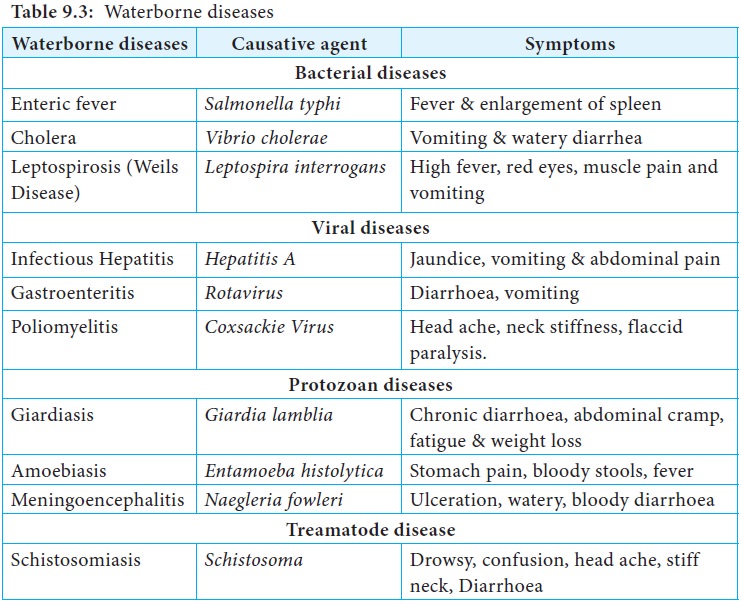Chapter: 11th Microbiology : Chapter 9 : Environmental Microbiology
Water Pollution and Microbial Contamination
Water Pollution and Microbial
Contamination
Water is polluted by both natural as well as man-made
activities. Polluted water is one which consists of undesirable substances
rendering it unfit for drinking and domestic use.
Sources of water pollutants
1.
Industrial waste
2.
Sewage waste
3.
Mining activities
4.
Marine dumping
5.
Accidental oil leakage
6.
Burning of fossil fuels
7.
Chemical fertilizers and pesticides
8.
Radio-active waste
The most prevalent biological contaminants in water are
microbes, particularly bacteria and viruses. Most of the bacteria carried by
storm runoff originate from animal fecal matter. Studies have shown that during
storms, the water that drains off the land and into sewage systems also carries
large quantity of bacteria and chemicals. The chemicals include pesticides
applied to lawns, chemical wastes near industrial plants, and organic matter
deposited o the ground by different sources. In addition to the chemical and
biological contaminants, physical properties also affect the quality of
biological life in water. Among these are pH, temperature, dissolved oxygen
concentration and salinity.
Potable Water
Clean water free from odour, disagreeable taste, harmful
chemicals, turbidity and microorganisms is called potable water, which is safe
to drink and can use for food preparation without risk of health problems.
Biological oxygen demand (BOD)
Biological oxygen demand is one of the common parameter to
monitor water quality and purity. BOD is the amount of dissolved oxygen needed
by aerobic organisms to break down organic material present in a given water
sample at certain temperature over a specific period of time. The amount of
decomposable organic material in sewage is measured by the biochemical oxygen
demand, or BOD. The BOD of the water sample is determined by aerating it,
measuring the amount of oxygen in sample before incubation, placing the sample
in a sealed container (BOD bottle) and incubating the container for five days
at 20°C. During this five day period, microorganisms in the water grow and
oxidize any organic materials in it. After incubation period, the BOD of the
water can be determined by measuring the quantity of residual oxygen in the
container. BOD of drinking water should be below 3ppm or 3mg/litre.
Indicator Microorganisms
Indicator organism are frequently used to monitor bacterial
contamination of
These indicator organisms provide a representative index
of the water contamination by pathogenic microbes. The indicator organisms
generally used in water quality monitoring are those that are associated with
the gastrointestinal tract and fecal matter. The most common group of indicator
organisms used in water quality monitoring are the coliforms, bacteria that are
Gram negative, aerobic or facultative anaerobic, non-spore forming rods that
ferment lactose with gas production within 48 hours at 35°C. Examples of
coliforms are Escherichia coli,
Enterobacter aerogenes and Klebsiella
pneumonia. Two analytical procedures were followed to check the presence of
coliforms in water. They are Most Probable Number (MPN) and Membrane
Filteration (MF) technique. The number of coliforms per 100ml of water sample
is estimated to find the quality of water and its suitability for drinking
purposes. In addition to coliforms, coli phages, Clostridia and human enteric viruses are also monitored in drinking
water.
Waterborne diseases
Waterborne diseases are posing a serious threat to health (Table
9.3).


Related Topics